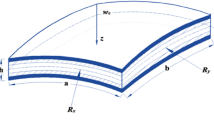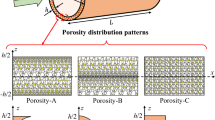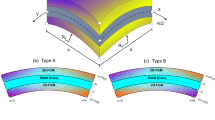Abstract
Background
The functionally graded materials (FGM) have excellent properties that make them suited for mechanical, automobile and aerospace applications. However, the presence of insidious porosity inside the bulk of the FGMs significantly alters their vibration response especially when working under thermal environment as in aero-engines, turbine blades and nuclear power plants.
Purpose
The paper presents a detailed investigation of the thermomechanical response of porous FGM blades that is crucial in order to ensure the safe service life of the structural components. The randomly varying porosity distribution is modelled mathematically using a cosine law whilst the material properties of the FGM constituents (metal and ceramic) are assumed to vary with the absolute temperature.
Methods
A finite element method (FEM)-based model is developed to predict the influence of porosity distribution and thermal gradient on the free vibration response of rotating functionally graded porous FGM fan blades idealised as cantilever pre-twisted rotating plates and shells with varying metal and ceramic FGM constituent combinations. The present formulation is based on first-order shear deformation theory wherein the internal non-linear rotational and thermal strains are taken into account based on suitably derived geometric stiffness matrices.
Results
The non-dimensional frequencies are studied based on variations in crucial parameters like power index, pre-twist angle, plate aspect ratio, porosity distribution pattern, rotational speed, blade taper ratio and thermal gradient across the FGM plate. The natural frequencies for a tapered cylindrical fan blade composed of SUS304/Si3N4 FGM constituents are studied for different temperature and porosity type.
Conclusions
For all the FGM constituent combinations considered, the highest fundamental frequency is observed for Porosity Type 1 followed by no porosity, Porosity Type 3 and Porosity Type 2. For a certain value of the power index, the fundamental frequencies are found to increase with an increase in the rotational speed. On the other hand, there is a reduction in the frequency values with an increase in the thermal gradient for all porosity types owing to internal stresses and material property degradation. The tapering of the fan blades and the porosity gradient are found to have significant influence on their natural frequency in thermal environment.











Similar content being viewed by others
References
Olson MD, Lindberg GM (1971) Dynamic analysis of shallow shells with a doubly-curved triangular finite element. J Sound Vib 19(3):299–318
Lee JK, Leissa AW, Wang AJ (1984) Vibrations of blades with variable thickness and curvature by shell theory. Trans ASME J Eng Gas Turbines Power 106:11-16
Reddy J (2000) Analysis of functionally graded plates. Int J Numer Methods Eng 47(1–3):663–684
Reddy JN, Chin CD (1998) Thermomechanical analysis of functionally graded cylinders and plates. J Therm Stresses 21(6):593–626
Vel SS, Batra RC (2002) Exact solution for thermoelastic deformations of functionally graded thick rectangular plates. AIAA J 40:1421–1433
Vel SS, Batra RC (2004) Three-dimensional exact solution for the vibration of functionally graded rectangular plates. J Sound Vib 272(3–5):703–730
Ferreira AJM, Batra RC, Roque CMC, Qian LF, Martins PALS (2005) Static analysis of functionally graded plates using third-order shear deformation theory and a meshless method. Compos Struct 69(4):449–457
Huang XL, Shen HS (2004) Nonlinear vibration and dynamic response of functionally graded plates in thermal environments. Int J Solids Struct 41(9–10):2403–2427
Matsunaga H (2008) Free vibration and stability of functionally graded plates according to a 2-D higher-order deformation theory. Compos Struct 82(4):499–512
Zhao X, Lee YY, Liew KM (2009) Free vibration analysis of functionally graded plates using the element-free kp-Ritz method. J Sound Vib 319(3–5):918–939
Neves AMA, Ferreira AJM, Carrera E, Roque CMC, Cinefra M, Jorge RMN, Soares CMM (2012) A quasi-3D sinusoidal shear deformation theory for the static and free vibration analysis of functionally graded plates. Compos B Eng 43(2):711–725
Taj MG, Chakrabarti A, Sheikh AH (2013) Analysis of functionally graded plates using higher order shear deformation theory. Appl Math Model 37(18–19):8484–8494
Kim J, Reddy JN (2013) Analytical solutions for bending, vibration, and buckling of FGM plates using a couple stress-based third-order theory. Compos Struct 103:86–98
Mantari JL, Soares CG (2013) A novel higher-order shear deformation theory with stretching effect for functionally graded plates. Compos B Eng 45(1):268–281
Bandyopadhyay T, Karmakar A (2015) Bending characteristics of delaminated cross-ply composite shallow conical shells in hygrothermal environment. J Reinf Plast Compos 34(20):1724–1735
Bandyopadhyay T, Karmakar A, Kishimoto K (2016) Transient response of delaminated composite conical shells due to multiple low velocity impacts in hygrothermal environment. Compos Struct 143:202–219
Bich DH, Ninh DG, Thinh TI (2016) Non-linear buckling analysis of FGM toroidal shell segments filled inside by an elastic medium under external pressure loads including temperature effects. Compos B Eng 87:75–91
Thang PT, Nguyen-Thoi T, Lee D, Kang J, Lee J (2018) Elastic buckling and free vibration analyses of porous-cellular plates with uniform and non-uniform porosity distributions. Aerosp Sci Technol 79:278–287
Gao K, Gao W, Chen D, Yang J (2018) Nonlinear free vibration of functionally graded graphene platelets reinforced porous nanocomposite plates resting on elastic foundation. Compos Struct 204:831–846
Cong PH, Chien TM, Khoa ND, Duc ND (2018) Nonlinear thermomechanical buckling and post-buckling response of porous FGM plates using Reddy’s HSDT. Aerosp Sci Technol 77:419–428
Zenkour AM (2018) A quasi-3D refined theory for functionally graded single-layered and sandwich plates with porosities. Compos Struct 201:38–48
Wu D, Liu A, Huang Y, Huang Y, Pi Y, Gao W (2018) Dynamic analysis of functionally graded porous structures through finite element analysis. Eng Struct 165:287–301
Kiran MC, Kattimani SC (2018) Assessment of porosity influence on vibration and static behaviour of functionally graded magneto-electro-elastic plate: a finite element study. Eur J Mech A/Solids 71:258–277
Kim J, Żur KK, Reddy JN (2019) Bending, free vibration, and buckling of modified couples stress-based functionally graded porous micro-plates. Compos Struct 209:879–888
Coskun S, Kim J, Toutanji H (2019) Bending, free vibration, and buckling analysis of functionally graded porous micro-plates using a general third-order plate theory. J Compos Sci 3(1):15
Bansal G, Gupta A, Katiyar V (2020) Vibration of porous functionally graded plates with geometric discontinuities and partial supports. Proc Inst Mech Eng C J Mech Eng Sci 234(21):4149–4170
Li S, Zheng S, Chen D (2020) Porosity-dependent isogeometric analysis of bi-directional functionally graded plates. Thin Walled Struct 156:106999
Dastjerdi S, Malikan M, Dimitri R, Tornabene F (2021) Nonlocal elasticity analysis of moderately thick porous functionally graded plates in a hygro-thermal environment. Compos Struct 255:112925
Genao FY, Kim J, Żur KK (2021) Nonlinear finite element analysis of temperature-dependent functionally graded porous micro-plates under thermal and mechanical loads. Compos Struct 256:112931
Tran TT, Pham QH, Nguyen-Thoi T (2021) Static and free vibration analyses of functionally graded porous variable-thickness plates using an edge-based smoothed finite element method. Defence Technol 17(3):971–986
Kumar V, Singh SJ, Saran VH, Harsha SP (2021) Vibration characteristics of porous FGM plate with variable thickness resting on Pasternak’s foundation. Eur J Mech A/Solids 85:104124
Yin Z, Gao H, Lin G (2021) Bending and free vibration analysis of functionally graded plates made of porous materials according to a novel the semi-analytical method. Eng Anal Bound Elem 133:185–199
Ninh DG, Hoang VNV, Le Huy V (2021) A new structure study: vibrational analyses of FGM convex-concave shells subjected to electro-thermal–mechanical loads surrounded by Pasternak foundation. Eur J Mech A/Solids 86:104168
Kumar HN, Kattimani S (2022) Effect of different geometrical non-uniformities on nonlinear vibration of porous functionally graded skew plates: a finite element study. Defence Technol 18(6):918–936
Van Vinh P, Van Chinh N, Tounsi A (2022) Static bending and buckling analysis of bi-directional functionally graded porous plates using an improved first-order shear deformation theory and FEM. Eur J Mech A/Solids 2022:14743
Karakoti A, Pandey S, Kar VR (2022) Nonlinear transient analysis of porous P-FGM and S-FGM sandwich plates and shell panels under blast loading and thermal environment. Thin Walled Struct 173:108985
Ramteke PM, Kumar V, Sharma N, Panda SK (2022) Geometrical nonlinear numerical frequency prediction of porous functionally graded shell panel under thermal environment. Int J Nonlinear Mech 143:104041
Ramteke PM, Panda SK, Patel B (2022) Nonlinear eigen frequency characteristics of multi-directional functionally graded porous panels. Compos Struct 279:114707
Fang J, Yin B, Zhang X (2022) Size-dependent vibrations of porous functionally graded rotating microplates under thermal environment. Eur J Mech A/Solids 95:104645
Thai S, Do DT, Tan TN (2022) Nonlinear bending analysis of variable thickness multi-directional functionally graded plates based on isogeometric analysis. Mech Adv Mater Struct 2022:1–19
Xiong S, Zhou C, Zheng X, An D, Xu D, Hu Z, Zhao Y, Li R, Wang B (2022) New analytic thermal buckling solutions of non-Lévy-type functionally graded rectangular plates by the symplectic superposition method. Acta Mech 233(7):2955–2968
Xiong S, Zhou C, Zhao L, Zheng X, Zhao Y, Wang B, Li R (2022) Symplectic framework-based new analytic solutions for thermal buckling of temperature-dependent moderately thick functionally graded rectangular plates. Int J Struct Stab Dyn 22(14):2250154
Ninh DG, Van Vang T, Ha NH, Long NT, Nguyen CT, Dao DV (2022) Effect of cracks on dynamical responses of double-variable-edge plates made of graphene nanoplatelets-reinforced porous matrix and sur-bonded by piezoelectric layers subjected to thermo-mechanical loads. Eur J Mech A/Solids 96:104742
Hu Z, Zhou C, Ni Z, Lin X, Li R (2023) New symplectic analytic solutions for buckling of CNT reinforced composite rectangular plates. Compos Struct 303:116361
Hu Z, Zhou C, Zheng X, Ni Z, Li R (2023) Free vibration of non-Lévy-type functionally graded doubly curved shallow shells: new analytic solutions. Compos Struct 304:116389
Hu Z, Shi Y, Xiong S, Zheng X, Li R (2023) New analytic free vibration solutions of non-Lévy-type porous FGM rectangular plates within the symplectic framework. Thin Walled Struct 185:110609
Long NT, Quan NM, Ha NH, Tan NC, Ninh DG, Thang VT, Eslami H, Dao DV (2023) Dynamical responses of variable generatrix profile and thickness ceramic-matrix composite shells under electro-thermo-mechanical effects. Thin Walled Struct 185:110592
Author information
Authors and Affiliations
Corresponding author
Ethics declarations
Conflict of interest
On behalf of all authors, the corresponding author states that there is no conflict of interest.
Additional information
Publisher's Note
Springer Nature remains neutral with regard to jurisdictional claims in published maps and institutional affiliations.
Rights and permissions
Springer Nature or its licensor (e.g. a society or other partner) holds exclusive rights to this article under a publishing agreement with the author(s) or other rightsholder(s); author self-archiving of the accepted manuscript version of this article is solely governed by the terms of such publishing agreement and applicable law.
About this article
Cite this article
Dey, T., Bandyopadhyay, T. Free Vibration Response of Porous FGM Plates Using Finite Element Analysis in Thermal Environment. J. Vib. Eng. Technol. 12, 4593–4615 (2024). https://doi.org/10.1007/s42417-023-01139-5
Received:
Revised:
Accepted:
Published:
Issue Date:
DOI: https://doi.org/10.1007/s42417-023-01139-5




